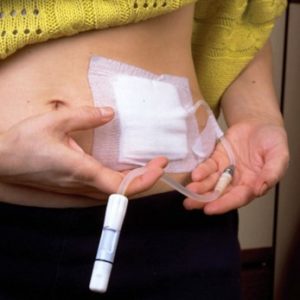Peritoneal dialysis, like haemodialysis, is not easy. It is hard work every day, partly as its not that effective. Both forms of dialysis provide about 5% of the function of two normal kidneys. Nonetheless if it works well, it can keep you alive for many years.

A peritoneal dialysis catheter
However, as for any life-saving long-term treatment, there are complications. We will now go through the short, medium and long-term complications of peritoneal dialysis (PD).
Short-term complications
Peritonitis. The commonest complication is a short-term bacterial infection of the lining of the abdomen called (bacterial) peritonitis. This shows itself as tummy pain and cloudy PD fluid.
A longer term infection can also be caused by tuberculosis. There can also be infections of the catheter exit site and tunnel. All need to be treated with antibiotics and other drugs. If that does not work, the PD catheter has to be removed.
Medium-term complications
There are other (non-infectious) medium-term complications including:
- Catheter drainage problems. This can be due to constipation. If encouraging the bowels to work is not effective, this may require an operation to reposition the PD catheter, or a new catheter (with the old one removed in the same procedure)
- Dialysis fluid leakage (around the catheter insertion site). Ditto
- Abdominal pain or discomfort. Some patients may experience abdominal discomfort or bloating during PD exchanges. This can be due to the volume of dialysis fluid or constipation
- Hernias. Increased intra-abdominal pressure from the dialysis fluid can predispose PD patients to the development of hernias, particularly in the abdominal wall or inguinal area. A hernia will need an operation to repair; as well as a short period on haemodialysis, to allow the tummy to heal.
Long-term complications
Poor ‘clearance’. Some patients – especially larger men after 18 months+ of dialysis – find that the peritoneal dialysis starts to be unable to clear (i.e. remove, hence the phrase ‘clearance’) enough toxin (like urea and creatinine) to keep you well. Then a swop to haemodialysis may be necessary.
Respiratory issues. In rare cases, a hole can form between the abdomen and chest, which leads to PD fluid accumulating around a lung (called a pleural effusion). This can leading to shortness of breath. It will reuire a pause in PD for weeks (or months), to repair.
High blood sugar (hyperglycaemia). The high glucose content of the dialysis fluid can raise blood sugar levels, particularly in individuals with diabetes. It may require adjustments to insulin or oral diabetes medications.
Sclerosing peritonitis. This is a long-term scarring of the peritoneum. It requires removal of the PD catheter.
Last Reviewed on 2 September 2023
